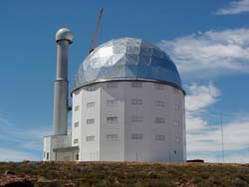Scientific heart of giant telescope comes together

In the spring of 2005, when the new Southern African Large Telescope (SALT) trains its huge eye on the southern sky for the first time, the starlight it gathers will be parsed and analyzed by an instrument more befitting a space-based telescope than a ground-based monster.
The instrument, known as the Prime Focus Imaging Spectrograph, will sit 10 stories above the 11-by-10-meter primary mirror of what will be the largest telescope in the Southern Hemisphere. Its station high above the light-gathering mirror, instead of in the bowels of the SALT Observatory, calls for the same compact, lightweight specs of an instrument destined for Hubble or other space-borne telescope.
"Because it is at the prime focus, it has to be a light, small and remotely operated," says Kenneth H. Nordsieck, a University of Wisconsin-Madison astronomer now overseeing construction of the $5 million device. "It weighs half a ton as opposed to 10 tons."
The instrument is now being assembled by a team of scientists and engineers in UW-Madison's Space Astronomy Laboratory in partnership with collaborators from South Africa and Rutgers University.
The $18 million SALT Observatory, 220 miles from Cape Town on a mountain plateau near the edge of the Kalahari Desert, is nearing completion, with first light anticipated in just a few months.
The observatory is being constructed by an international consortium of government and academic institutions, including UW-Madison. When completed, it will give Wisconsin astronomers and their students access to the largest optical telescope in the Southern Hemisphere, bringing within reach objects of immense interest to astronomy.
The Magellanic Clouds, our nearest galactic neighbors, will be within the SALT Telescope's field of view. What's more, the telescope's location in the Southern Hemisphere will allow astronomers to probe the center of our own galaxy, the Milky Way.
"The Milky Way is very impressive from the Southern Hemisphere," says Nordsieck. "Also, placement of the telescope in South Africa means we're in one of the darkest places in the world. There are no cities down there. It's very dark. If you're an astronomer, that's where you want to be."
In addition to SALT's prime Southern Hemisphere location and large segmented mirror, consisting of 91 identical 1-meter hexagonal mirror segments, the Prime Focus Imaging Spectrograph now being assembled in a Chamberlain Hall clean room will give astronomers unique observing capabilities.
"The whole telescope is aimed at spectroscopy," says Nordsieck.
Spectrometers are designed to break light down into different wavelengths. The spectra they gather are highly diagnostic and provide astronomers with far more information than simple pictures. Spectrometers, Nordsieck explains, can be designed to be especially good at detecting specified chunks of the continuum of light that penetrates the Earth's atmosphere from space.
"One of our instrument's specialties is the near ultraviolet, sunburn territory," Nordsieck says, referencing the swath of the electromagnetic spectrum that the device is designed to sample. "This is one of the few big instruments that will be good in the ultraviolet.
"Another unusual capability of our instrument is that it can take spectra at a rate of twenty times a second," the Wisconsin astronomer notes. "That kind of resolution is good for small objects like neutron stars, gamma ray bursts and black holes."
In fact, says Nordsieck, it will be capable of taking movies of dynamic objects and phenomena such as eclipses, pulsing stars and comets.
Besides capturing the spectral signatures of stars and galaxies, the imaging spectrograph will be able to serve up insight into the geometry of objects through polarimetry. Light waves become polarized as they bounce off objects or are pushed and pulled by the magnetic fields of interstellar space. That kind of interaction helps probe the structure of objects between the source of starlight and observers on Earth.
Finally, as the Prime Focus Imaging Spectrograph ‘s name implies, the device will be capable of simultaneously capturing images and spectra of distant stars, galaxies and the host of celestial objects of interest to astronomers.
"The instrument is almost all refracting optics - lenses," explains Nordsieck.
Fittingly, one set of lenses is made of pure sodium chloride, or salt.
The novel scientific instrumentation of the new device, together with the SALT Telescope's large mirror and prime location, promises a unique new window to the southern skies, Nordsieck says.
"It's going to be the best spectropolarimeter on the planet. We can't wait to get it up and running."
Source: UW-Madison
















